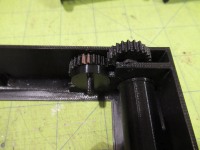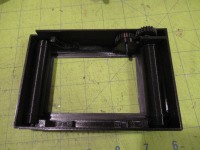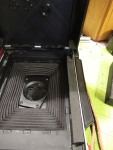


Download the 3D files here and print each of the files using supports and 3 top and bottom layers for light tightness. You can also send the an STL file with all the pieces to any print service (try Craftcloud3d for a pretty good quote in your area),, or you can order them from PCBWAY which quotes around $38US for this project.
Insert the drive gear in the upper left of the cartridge. It'll install with a gentle snap. Mount the thumb gear in the two holes to the right of the drive gear with a small screw or pin (an old Polaroid hinge works) and be sure it turns the drive gear easily. IMPORTANT: mark the top of the drive gear (white paint) when the drive tab is vertical. This mark will be used to remove the film spool.
The roller ends were made slightly too large, so file off the ridges and file them them down slightly and evenly until the rollers fit into the indents in the sides of the cartridge and spin freely. A little resistance is acceptable. Don't file them down too much or they'll dislodge while operating.
Remove the original back door by removing the hinge (you may have to remove the plastic pieces at both ends of the hinge) and install the new door. It may be tricky to align the hinge while inserting it. It would be best to insert the hinge pin into the 3D printed door before installing it, to ensure the print left enough room for the hinge. Close the door while pressing on the release latch and be sure the latch engages securely. If the latch doesn't seem to return freely, file a bit off of the bottom and tip of the latch hooks on the back. Be careful as the hooks are somewhat fragile. You can either cut/glue a red filter over the film counter hole, or you can place a piece of black tape over it to prevent light leaks through the exposure counter hole.
Line the top edge of the film compartment with 2mm black craft foam to prevent light leaks from the top of the door. Alternatively, you can glue a piece of craft foam onto the outside of the cartridge, butting it up to the top of the film bay while it's installed in the camera.
Feel free to contact me with any questions or news about your build!